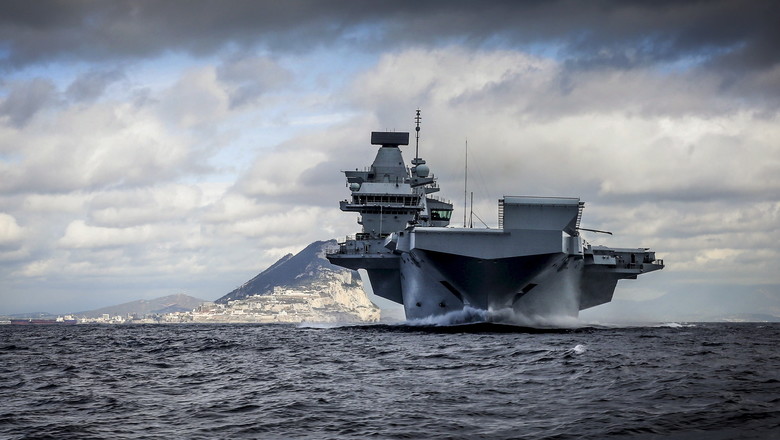
Aircraft carrier’s workforce protected by all-purpose
Emergency Response Team

HMS Queen Elizabeth (QNLZ) and HMS Prince of Wales (PWLS), the largest warships ever built for the Royal Navy, were constructed by thousands of people at Babcock’s secure site in Rosyth, north of Edinburgh. A team of specialist security officers trained to fight fires, deliver first aid, navigate confined spaces and rescue at height, protected workers throughout the assembly and commissioning phases.
29 Jul 2020
The first time Lynsey Burns saw HMS Prince of Wales aircraft carrier, it was a block of steel the size of a suburban house. It was late 2014, and she had just joined a specialised squad protecting workers on the ship, which was being constructed at Babcock’s Rosyth site.
HMS Prince of Wales, along with its sister ship, HMS Queen Elizabeth, are the largest UK Royal Navy vessels in history. At 280 metres long, they are longer than the UK’s Houses of Parliament in London. Each with a displacement of 65,000 tonnes, they can carry up to 40 aircraft and 1,600 people. “It was a floating city, eventually,” Lynsey said.
Over eight years of construction, G4S also protected the larger 300 acre site: its people and the project, providing fire and security equipment, support for major events and expert modelling to manage risks. Crucially, a G4S team of men and women trained as all-purpose first responders - firefighters, paramedics and search and rescue professionals - constantly patrolled the aircraft carriers.
Known as the Emergency Response Team (ERT), they also provided support to the whole site, with activities ranging from Engineering and ship maintenance, to building critical national infrastructure that requires security controls, independently audited by external third parties.
The construction of the QEC aircraft carriers was a once in a lifetime project,
“We had the opportunity to work on critical infrastructure and demonstrate how we design a security solution tailored to this project’s needs. It was a bespoke service to this unique project.”
Phil Gachagan, a former Police Scotland Detective Chief Inspector who joined G4S at Rosyth in January 2018, said: “I was hired to manage the team and expected it would be mostly conventional security work. Instead, I was managing a multi-skilled specialist resource and a security team.”

‘Two skyscrapers built horizontally’
Constructing ships on that scale required extraordinary engineering, as well as an unbelievable amount of resources. As one of the largest defence engineering projects, more than 3,100km of electric cable, 2 million metres of fibre optic cable, 364km of piping, 41km of ventilation trunking and 65,000 tonnes of steel were used for each ship.
More than 7,000 people worked on-site at its peak, and 51 million ‘working hours’ went into their design and construction.
More than 7,000 people worked on-site at its peak, and 51 million ‘working hours’ went into their design and construction.
The ships were described by those on-site as two horizontal, floating skyscrapers. An enormous Goliath crane, purpose-built for the project, lifted pre-built sections into a dry dock, where construction workers and engineers assembled rooms, steel and cables together.
The Aircraft Carrier Alliance (ACA) – an alliance between Babcock International Group, BAE Systems, Thales and the Ministry of Defence, was established to deliver them.
Patrolling the site in distinct red overalls throughout construction were the Emergency Response Team officers. “We were involved with this project from the planning stage, through to the development, delivery, refining and completion stages,” Brian said. “It’s been an amazing voyage already.”
Each ship had a dedicated team trained in fire rescue, rescues at height, confined space rescue and water based rescue. “They’re trained by serving fire officers,” Phil said. “They have the same equipment, the same breathing apparatus, fire hoods, tunics and helmets, as the fire service.”
During construction, they aimed to be able to get to the scene of an incident within two minutes.
Throughout the project, the team responded to first aid incidents, heart attacks and fires. The ERT officers also drew from their training to report any potentially unsafe conditions, preventing other accidents from taking place.
“The ERT maintained a safe and secure environment,” Brian said. “If an incident did occur, their immediate response greatly minimised the impact of those incidents.”
While the ships were being painted, ERT officers trained in water rescues patrolled the waters below in a small vessel, and construction workers regularly told the team their red uniform was a reassuring sight on the flight deck.
Vice Admiral Sir Simon Lister was the Managing Director of the ACA, which built the ships. “The ER Team from G4S made a great contribution to the PWLS project,” he said.
Knowing that a professional team of first responders was at immediate notice to help, gave everyone on-board a feeling of confidence, and formed the foundation of our safety culture. When incidents occurred, the team was always grateful for the swift and effective interventions by the ERT.

Leveraging the wider G4S business
Throughout the near-decade of preparation and construction, the ERT was supported by many other areas of G4S.
G4S’s fire and security business installed evacuation and mustering systems. The G4S Events business provided expertise and support for large-scale events on site, some of which were being broadcast live around the world. The G4S Canine business and Risk Experts also provided additional support at times throughout the project.
G4S’s fire and security business installed evacuation and mustering systems. The G4S Events business provided expertise and support for large-scale events on site, some of which were being broadcast live around the world. The G4S Canine business and Risk Experts also provided additional support at times throughout the project.
“We drew from the expertise across the G4S group of businesses, continually developing and evolving our solution to meet the needs of this unique construction project,” Brian said. More than 100 G4S staff in two units managed physical security and specialist emergency response.
A single fire alarm going off meant an entire ship had to be evacuated and searched. Workers had identity cards that they scanned to go on and off the ship, meaning the ERT officers always knew how many people were still on-board.
The team was trained to assess security threats and to identify and isolate any potential risks, but also to be flexible - to be genuine, friendly people. In July 2014, HMS Queen Elizabeth was officially named to huge fanfare.
Thousands of people - including Her Majesty the Queen - arrived on the site. Throughout construction, there were major visits from many other dignitaries, including former British Prime Ministers, David Cameron and Theresa May.
Shaun Fyfe was the Operations Coordinator for G4S at the Babcock site and has since taken up the role of Service Delivery Manager. A former Royal Guard at Buckingham Palace, he joined the team as a security officer to be closer to home and family.
“We have responsibility for all ships that come in. All ships are here for maintenance and in-service support,” he said.
Lynsey, now a supervisor, added: “I wanted to be on-board the aircraft carrier, on the flight deck, and that’s exactly what I got to do.”

ERT becomes SERT
Those at the Rosyth site knew their time protecting workers on the aircraft carriers would slowly come to an end. As each ship was finished and prepared to leave, Phil and Brian prepared to transition the ERT officers to other roles, and to create one hybrid security squad.
“The number of ERT staff needed to patrol the site reduced, but we needed to retain their skill-set, expertise and knowledge,” Phil said.
“So we merged both security and ERT activities into one - an unprecedented move - and minimised the number we had to make redundant. In the end, there were no dedicated ERT roles.”
A small core team was kept, most of whom knew the aircraft carriers intimately.
“The number of ERT staff needed to patrol the site reduced, but we needed to retain their skill-set, expertise and knowledge,” Phil said.
“So we merged both security and ERT activities into one - an unprecedented move - and minimised the number we had to make redundant. In the end, there were no dedicated ERT roles.”
A small core team was kept, most of whom knew the aircraft carriers intimately.
I now have more security officers on site 24/7 who are trained in the event of an incident. The SERT team has been very flexible and adapted to what we wanted to do
Andy Lane, G4S Secure Solutions UK’s Chief Operating Officer, said the project highlighted the confidence each party had in each other.
“Seeing the team working closely with Babcock to overcome all the challenges a highly complex project such as this brings demonstrated the trust both parties have for each other,” he said.
“Then to adapt and future-proof the service and the reputation of the site operation showcases local management and all team members as great ambassadors for both companies.”
The officers continue to monitor the site, protect commercial and naval ships in port, and will be ready when Babcock begin building new Royal Naval Type 31 frigates at Rosyth next year.
When the Prince of Wales sailed out of the dock on September 19, 2019, it was an emotional time for the now SERT officers. “I invested five years of my life on her,” Lynsey said. Lee said he pays attention any time the ships are mentioned in the news. “You think, ‘wait, what’s it doing now?’ We’re connected to those ships.”
